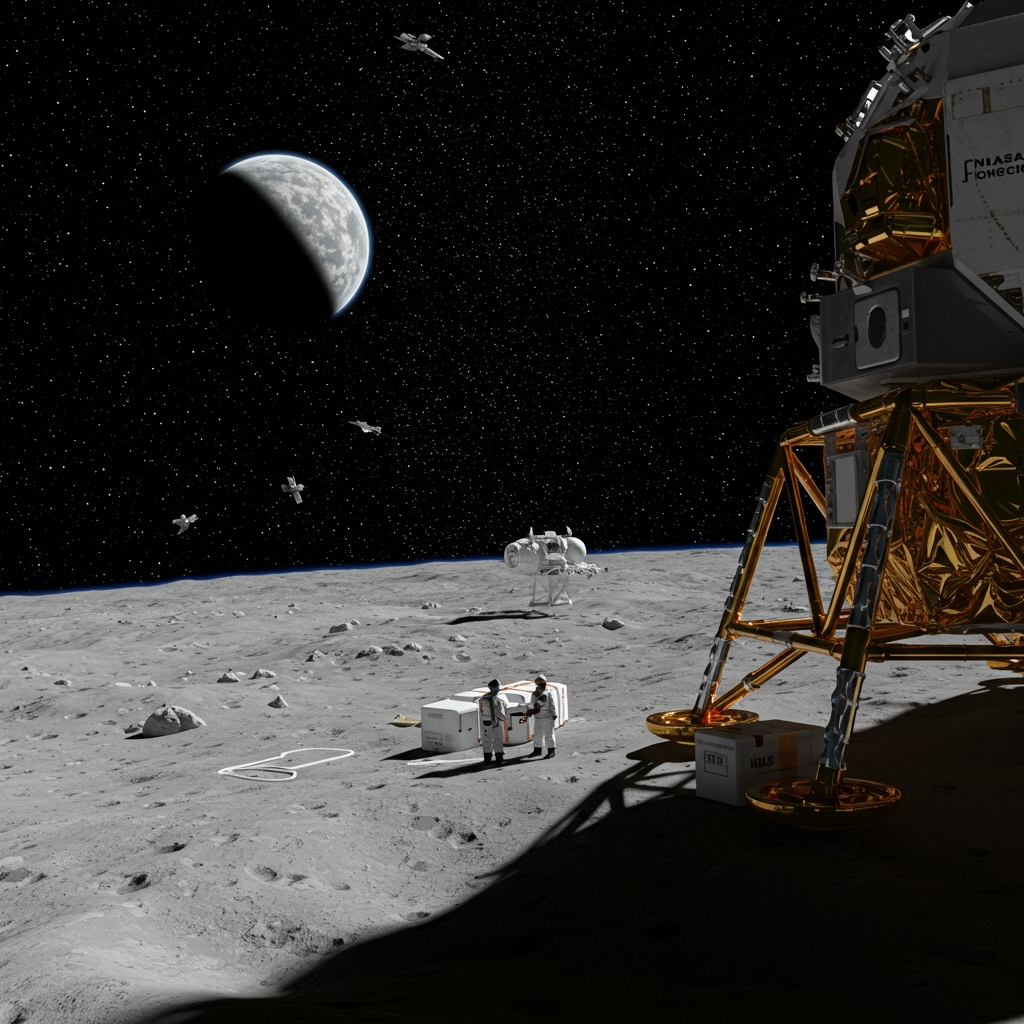NASA Confirms Successful Ares-IV Lunar Landing, Paving Way for Artemis Base Camp Alpha
CAPE CANAVERAL, FL – February 10, 2025 – NASA today announced a monumental step forward in its ambitious Artemis program, confirming the successful uncrewed landing of the Ares-IV lunar lander on the surface of the Moon. This mission marks a critical milestone in the agency’s efforts to establish a sustainable human presence on our celestial neighbor, specifically targeting the resource-rich yet challenging lunar south pole region.
The Ares-IV lander, a robotic precursor mission designed to deliver essential infrastructure ahead of future crewed flights, touched down precisely as planned at 03:15 UTC on February 10, 2025. Its destination: the vicinity of Shackleton Crater, a key location near the lunar south pole identified as the future site for Artemis Base Camp Alpha.
Launched just over two weeks prior, on January 28, 2025, the Ares-IV mission began its journey aboard a SpaceX Falcon Heavy rocket from Launch Complex 39A at NASA’s historic Kennedy Space Center in Florida. The powerful heavy-lift vehicle successfully placed the transfer vehicle and lander stack on a trajectory towards the Moon, initiating a transit phase that culminated in today’s successful landing.
The primary objective of the Ares-IV mission was to deliver a vital payload weighing a total of 1,500 kg to the lunar surface. This cargo is not merely supplies; it represents foundational elements critical for the long-term habitation and sustainability of a lunar outpost. The payload includes advanced prototypes specifically designed to address the unique challenges of the lunar environment and support future astronaut operations.
Among the key components delivered are advanced oxygen production units. These systems are integral to In-Situ Resource Utilization (ISRU), the process of using local lunar materials – such as water ice believed to be abundant in the permanently shadowed regions near the south pole – to create breathable air and propellant. Establishing reliable oxygen generation on the Moon significantly reduces the mass of life support consumables that must be launched from Earth, a crucial factor for affordability and sustainability.
Also included in the 1,500 kg payload are modular solar array prototypes. While the lunar south pole experiences periods of near-constant sunlight on some high points, it also presents extreme temperature variations and long shadows. These modular arrays are designed for robustness, efficiency, and ease of potential deployment and expansion by future crews, providing the necessary power generation capabilities to operate habitats, scientific instruments, and ISRU systems through the long lunar day.
Agency officials hailed the successful landing as a pivotal achievement for the Artemis program. The precision touchdown in the chosen region near Shackleton Crater demonstrates enhanced guidance, navigation, and control capabilities essential for landing complex payloads at specific, hazardous locations required for base operations. The lunar south pole, with its potential for water ice, is strategically vital but also technically demanding due to challenging terrain and unique lighting conditions.
Confirmation of the landing’s success came rapidly as the lander began transmitting data back to Earth. Initial telemetry confirmed that the touchdown occurred as planned and, critically, that all onboard systems and the delivered equipment are operational. This verification is paramount, ensuring that the valuable cargo survived the rigors of launch, transit, and landing and is ready for its intended purpose.
The equipment delivered by Ares-IV is specifically intended to be integrated into the infrastructure of Artemis Base Camp Alpha. This future base, envisioned as a sustained habitat and research station, will serve as humanity’s first long-term foothold beyond Earth. The oxygen generators and solar arrays are foundational elements required before astronauts can occupy the site for extended periods.
According to NASA’s current planning, the integration of this pre-deployed equipment will occur during the planned Artemis IV crewed mission. Scheduled for late 2027, Artemis IV will be a complex mission involving the Starship human landing system and the delivery of additional elements, including habitat modules. Astronauts on that mission will be tasked with setting up and activating the systems brought by Ares-IV, preparing the base for subsequent, longer-duration stays.
The success of the uncrewed Ares-IV landing validates key technologies and operational procedures necessary for future human missions. It demonstrates NASA’s commitment to a phased approach for Artemis, utilizing robotic missions to reduce risk and build infrastructure ahead of human arrival. The successful delivery of critical life support and power generation equipment moves Artemis closer to its goal of establishing a sustainable human presence on the Moon, not just for returning, but for staying and learning to live and work in the deep space environment.
This mission underscores the international and commercial partnerships driving Artemis, leveraging capabilities like the Falcon Heavy launch vehicle. As data continues to stream back from the Ares-IV lander, engineers and scientists will gain invaluable insights into the performance of the lander and the status of the equipment in the harsh lunar south pole environment, further refining plans for Artemis Base Camp Alpha and humanity’s enduring return to the Moon.





